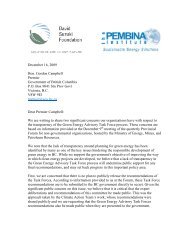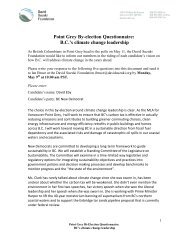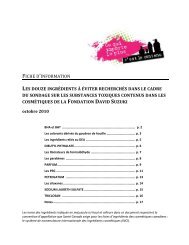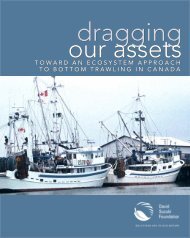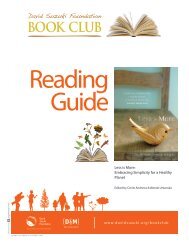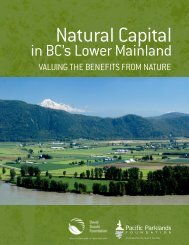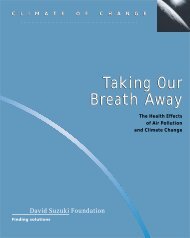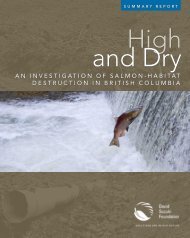A geneticist's personal perspective - David Suzuki Foundation
A geneticist's personal perspective - David Suzuki Foundation
A geneticist's personal perspective - David Suzuki Foundation
Create successful ePaper yourself
Turn your PDF publications into a flip-book with our unique Google optimized e-Paper software.
BIOTECHNOLOGY :A GENETICIST’S PERSONAL PERSPECTIVEby <strong>David</strong> <strong>Suzuki</strong>Dr. Faustus, Dr. Frankenstein, Dr. Moreau, Dr. Jekyll, Dr. Cyclops, Dr. Caligari, Dr. Strangelove.The scientist who does not face up to the warning in this persistent folklore of maddoctors is himself the worst enemy of science. In these images of our popular culture residesa legitimate public fear of the scientist’s stripped down, de<strong>personal</strong>ized conceptionof knowledge — a fear that our scientists, well-intentioned and decent men and womenall, will go on being titans who create monsters. —Theodore RoszakA Personal HistoryI would like to begin by providing some history and context that may inform you on where my <strong>perspective</strong>comes from. I was born in Vancouver, B.C., in 1936. Both of my parents were born in Vancouver about25 years earlier. In 1942, my Canadianborn and raised family was stripped of all rights of citizenship, ourproperty and assets were seized and sold at fire sale prices, our bank accounts were frozen and ultimatelylooted and we were incarcerated for three years in primitive camps located deep in the Rocky Mountains.Our crime was sharing genes with Canada’s enemy, who were also our enemy because we were Canadians.As World War II was drawing to an end, we were confronted with two choices: renounce citizenship andreceive a one way ticket to Japan or leave B.C. by moving east of the Rocky Mountains.Pearl Harbor and our subsequent evacuation, incarceration and expulsion, shaped the lives and psycheof all Japanese-Canadians. For me, those events created my hang-ups (about my slitty eyes) and drive toprove my worth to fellow Canadians. And the results of the war left me with a lifelong knee-jerk aversionto any hint of bigotry or discrimination and a passion for civil rights.Falling in Love with GeneticsAll my life, nature was my touchstone, my life, my passion. As a boy, my love of fish and fishing led toa hope of becoming an ichthyologist. Later, when my mother sewed me a net for collecting insects, mydreams were transformed to a life of entomology. After moving to Ontario at war’s end, I was fortunatein receiving a generous scholarship to Amherst College where I did an honours degree in biology and fellmadly in love with the elegance and precision of genetics. I declined my acceptance to medical school in1 Biotechnology: A Geneticist’s Personal Perspective
Molecular Genetics - History Repeats ItselfWhere did the doctor’s great project go wrong? Not in his intentions which were beneficent,but in the dangerous haste and egotistic myopia with which he pursued his goal. Itis both a beautiful and terrible aspect of our humanity, this capacity to be carried awayby an idea. For all the best reasons, Victor Frankenstein wished to create a new and betterhuman type. What he knew was the secret of the creature’s physical assemblage; heknew how to manipulate the material parts of nature to achieve an astonishing result.What he did not know was the secret of <strong>personal</strong>ity in nature. Yet he raced ahead, eagerto play God, without knowing God’s most divine mystery. —Theodore RoszakJust as eugenicists early in the 20th century became intoxicated with the discoveries being made,molecular biologists have created a climate of belief in the basic role of genes in just about every humantrait. Powerful tools to isolate and manipulate DNA confer truly revolutionary powers. Almost weekly,headlines proclaim the latest isolation of a gene for a trait, from risk taking to depression, shyness,alcoholism and homosexuality. Few note that in the months after the initial claims, follow ups generallyfail to corroborate the original claim or show the hereditary involvement is far more complex.One of the big mistakes made is a confusion between correlation and causation. Take, for example, thegene controlling the enzyme, alcohol dehydrogenase (adh). There exist two different states of this gene,adh A and adh B . Suppose a study demonstrates that 80 per cent of alcoholics have the adhA gene while 80per cent of non alcoholics have adh B . That is a correlation. But it is completely incorrect to conclude thatadh A causes alcoholism, yet the press and even scientists themselves frequently fall into that trap. Think of itthis way. Suppose you study all people who die from lung cancer in Vancouver over the past ten years anddiscover that 90 per cent of them had stained yellow fingers and teeth. That is a correlation. Who wouldever conclude that stained yellow fingers and teeth cause lung cancer? Yet it happens over and over whenmolecular biologists isolate fragments of DNA that correlate with traits, some as diverse and complex inexpression as homosexuality.Rapid Growth of Revolutionary ScienceGenetic engineering (GE) is a truly revolutionary area of science, made possible by the incredible speed andpower of newly acquired techniques. I graduated as a fully licensed geneticist in June 1961. At my graduation,someone casually asked me how soon I thought we would know how words are spelled out in DNA. I puffedup with my new PhD in hand and pronounced “Well, maybe when I’m getting ready to retire.” In Decemberof that year, the first word had been deciphered and within four, the entire dictionary was known. I preferto tell that story to illustrate the remarkable speed of discovery, not my ignorance and poor prognosticatoryability. When my daughter was in her last undergraduate year of university, she isolated, sequenced and5 Biotechnology: A Geneticist’s Personal Perspective
A Personal Moratorium on GEMy own <strong>personal</strong> experience with the consequences of well-intentioned but scientifically unjustifiedclaims and the insights I had gained while trying to answer my students’ questions had made it clear to methat there was a very important need for scientists to engage in public discussions about the significanceand implications of their work. Because I wanted to be able to participate credibly in this discussion, Ideclared in a 1977 column in Science Forum:Can the important questions be addressed objectively when one has such high stakes incontinuing the work? I doubt it. Therefore, I feel compelled to take the position thatnosuch experiments [on recombinant DNA] will be done in my lab; reports of such experimentswill not acknowledge my grants; and I will not knowingly be listed as an author ofa paper involving recombinant DNA.I had achieved far more in science than I ever dreamed or hoped. It had been the joy of research thatabsorbed me for a quarter of a century. I loved the excitement and camaraderie of the lab. I was proud of ourgroup, at one time the largest in Canada, and the work we did. But it was the muddy area of extrapolation ofscientific insights to broader society that concerned me because there were numerous examples of individualsmaking claims far beyond their scientific legitimacy. I felt that some of us whose careers and reputations werenot in jeopardy had to forego this work in order to take part, as scientists, in the discussions of the moral andethical questions free from the bias of vested interest in the work. Scientists working for the nuclear, tobaccoand petrochemical industries, either as employees or recipients of research grants, speak from a <strong>perspective</strong>of with a stake in continuing income and research support, and therefore it’s natural that they would tend todeflect criticism rather than discuss it openly. There was no reason to suppose that scientists in biotechnologywould be any different. Eventually I stopped taking government grants altogether because grants are awardedby peers, almost all of whom are promoters of research without regard to social or ethical concerns. I didn’twant to be dependent on, and thus vulnerable to, the influence of outside agendas.Damned if I Do, Damned if I Don’tAs a popularizer of science through newspaper columns, television and radio, I am able to survey a farbroader range of topics and questions than I ever did as a research scientist. Rather than losing my interestin the field of biotechnology and all of its implications, I have a broader <strong>perspective</strong> to reflect upon andhave written extensively on the subject over the years. In 1986, I discussed moral and ethical issues ofgenetics in my autobiography, Metamorphosis: Stages in a Life. I wrote syndicated columns on genetics thatbecame chapters in the bestselling books, Inventing the Future and Time to Change. In 1988, science writerPeter Knudtson and I coined the term “genethics” and co-wrote Genethics: The Ethics of Engineering Lifethat became a bestseller and continues to be widely used in university courses.7 Biotechnology: A Geneticist’s Personal Perspective
So it has been puzzling to me when individuals, some not even scientists, but spokespeople for thebiotechnology industry, call my credibility into question. I deliberately gave up the day-to-day excitementof scientific research in order to remain a credible discussant on the moral and ethical implications of thenew genetics. But I didn’t forget all I’d learned and practiced as a scientist. At the very least, all of us whoparticipate in the discussion ought to be forthright about the sources of our funding, position in companiesand any other factors that might influence our <strong>perspective</strong>s and bias our statements.Biotechnology is HereToday products of biotechnology are being rammed into our food, onto our fields and into our medicines,without any public participation in discussions and with the complicity, indeed, the active support andfunding of governments. But there are profound health, ecological and economic ramifications of thisactivity. At the heart of biotechnology is the ability to manipulate the very blueprint of life, removingand inserting segments into diverse species for specified ends. While plant and animal breeding over thepast 10 millennia have built the agriculture we depend on, biotechnology takes us far beyond the crudetechniques of breed and select. It behooves us therefore to examine the underpinnings of the claims,potential and limits of this young field.Biotechnology to Feed the WorldPerhaps the most frequently cited rationale to get on with genetic engineering as rapidly as possible goeslike this: human population continues to increase by more than 80 million a year, most in the developingworld. In order to avoid clearing more forests and draining wetlands to meet this need, proponentsargue, the only option to protect nature and feed the masses is to increase yields per hectare throughbiotechnology. It’s an argument that carries a lot of weight despite the irony that the number of peoplesuffering from severe malnutrition is about equal to the number of people afflicted with obesity in therich nations. However, biotechnology is being driven by vast sums of speculative money. In order to justifythose investments and to attract even more money, a product is needed. That’s why so many companieshave already foundered - they’ve failed to live up to the hype. The very survival of biotech companiesdepends on the expectation of profits from the company’s products. Those products are made at enormouscost. But the people who are most desperately in need of food are also the poorest. James Wolfensohn,President of the World Bank, claims that 1.3 billion people exist on a dollar or less a day while threebillion struggle on $2 or less daily. It would be a breathtaking reversal if free enterprise capitalists weresuddenly overwhelmed with generosity and concern for those less well off and make GE productsavailable at prices the needy can afford. Feeding the starving masses through biotech in the near future is acruel hoax that cannot be taken seriously.8 Biotechnology: A Geneticist’s Personal Perspective
The Real Nature of Scientific KnowledgeI have no doubt there will be important products that come out of genetic engineering — but in the moredistant future. It is the profit-driven rush to grow GE organisms in the open where they may contaminateother species and to introduce new products into the market that is most disturbing. My major concernsare based on simple principles. Every scientist should understand that in any young, revolutionarydiscipline, most of the current ideas in the area are tentative and will fail to stand up to scrutiny overtime. In other words, the bulk of the latest notions are wrong. This is by no means a knock on science, itis simply an acknowledgement that science progresses by demonstrating that current ideas are wrong oroff the mark. The rush to exploit new products will be based on inaccurate hypotheses and questionablebenefits could be downright dangerous.I graduated as a fully licensed (ie, with a PhD) in genetics in 1961. It was eight years after Watson andCrick’s famous paper and we had learned a lot - we knew about DNA, the number of human chromosomes,the operon, etc. But today when I tell undergraduates about the hottest ideas of chromosome structure andgene regulation in 1961, they laugh in disbelief. In 2003, the best notions of 40 years earlier seem naïve andfar from the mark. But those students are less amused when I suggest that 20 years from now when they areestablished scientists, the ideas they are excited by now will seem every bit as quaint as the ones I was excitedby in my early days. In any new area, scientists make a series of observations then set up a hypothesis thatmakes sense of the observations. That hypothesis enables a researcher to design experiments to test its validity.When the experiment is performed and the data gathered, chances are the hypothesis will be discarded orradically altered and then further experiments are suggested. That’s how science proceeds.Not Quite ReadyWhen a biotechnologist can clip out or synthesize a specific sequence of DNA, insert it at a preciselyspecified position in a host genome and obtain the predicted expression of the inserted DNA with no othercomplications, then we can say that it is a “mature” discipline. Of course, when that happens, one can’t publishpapers on such a manipulation because it will be old hat. If you’ve checked biotech publications these days,you’ll be amazed at their number and variety. Those reports are based on experiments where we didn’t knowwhat the results would be, after all that’s why experiments are done and reported. Doesn’t the abundance ofbiotech papers inform us that we still have a huge amount to learn? That suggests strongly that the disciplineis far from mature enough to leave the lab or find a niche in the market.The problem with biotechnology as it’s presented today is that those pushing its benefits stand to gainenormously from it. While I believe their sincerity, they obviously start from a faith in the benefits andour ability to “manage” the GE organisms and products safely. But we’ve learned from experience with thetobacco, nuclear, petrochemical, automobile and pharmaceutical industries and military establishments9 Biotechnology: A Geneticist’s Personal Perspective
that vested interest alone shapes a spokesperson’s <strong>perspective</strong> and precludes an ability to examine criticismsor concerns in an open fashion.Linear Science - An IllusionPromoters of biotechnology foster a version of how science proceeds that is totally at odds with realscience. They confuse the way scientists write grant requests with reality. The game scientists play in grantapplications is to act as if the money will be used to do experiment A which will lead to experiment B andon to C and D and, then voila, a cure for cancer. Scientists perpetuate this illusion that science progressesthis way as justification for receiving a grant. It’s as if scientific discovery proceeds in a linear way - butnothing could be further from the truth. Experiment A is carried out because we don’t know what theresults will be, so we have no idea where the results and then subsequent experiments will lead us. That’swhy despite all of the hoopla over biotechnology, so few concrete products have come forth and there isconsiderable controversy surrounding those that have reached test plots or the marketplace.The great strength of science is in description. We discover things wherever we look because despite theenormous growth of science in the 20th century, our knowledge of how the world around us works is stillminiscule. Scientists like University of Victoria biologist Tom Reimchen use powerful analytic tools toreveal astonishing secrets in nature. Thus, it has long been known that salmon need the forest to keep riverwater cool and spawning gravels free of silt; because when forests along watersheds are clearcut, salmonpopulations plummet or disappear. But Reimchen has used the relative abundance of the isotope N 15 inthe ocean in contrast with its rarity on land, to trace N 15 brought by salmon through the forest community.He has shown that salmon flesh is consumed by dozens of species including wolves, eagles, bears,flies, slugs and salamanders, and spread through the forest in their excrement. Examining cores of treesalong salmon rivers, Reimchen can correlate the width of tree growth rings with both the size of runs andamount of N 15 . This is descriptive science at its best, teasing secrets from nature and revealing that in thereal world, everything is connected to everything else. And that is what the remarkable tools of biotechnologypromise as well, an opportunity to dissect out nature’s secrets at the cellular level.DDT — A Case StudyThe fatal weakness of science is in prescription of solutions. A classic example is DDT, a complex ringmolecule first synthesized in the 19th century that Paul Mueller in the 1930s found kills insects. Thepower of chemistry to control a scourge that had plagued humankind since the beginning of time wastrumpeted widely. At the time Mueller made his discovery, geneticists knew enough to have suggestedthat using an insecticide would simply select resistant mutants that would eventually replace the sensitivesand thereby set farmers onto a treadmill of requiring an endless string of different pesticides. Ecologists ofthat time could have suggested that of all animals in the world, insects are the most numerous and diverse,10 Biotechnology: A Geneticist’s Personal Perspective
and play critical ecological roles like pollination, predation, and feeding other species. Perhaps one or twoinsect species per thousand species are pests to human beings. Using a broad-spectrum insecticide to getat the one or two species that are a nuisance to humans seems analogous to killing everyone in a city tocontrol crime — pretty crude and unacceptable.But in the exuberance over the power of chemistry, geneticists and ecologists failed to raise concerns,millions of kilograms of DDT were manufactured and used and Paul Mueller won a Nobel prize in 1948.Years later, bird watchers began to notice that birds, expecially raptors like hawks and eagles, were declining.Biologists tracked it down and discovered that although the pesticide was sprayed at concentrations ofparts per tens of millions, the molecule was absorbed by microorganisms. They in turn were eaten by largerorganisms and at each trophic level up the food chain, DDT was concentrated many fold. At the top ofthe chain, in the fatty tissue of birds’ shell glands or women’s breasts, DDT was concentrated hundreds ofthousands of times! This is known as biomagnification, a widespread biological phenomenon that was onlydiscovered when eagles began to disappear. Our knowledge of how the world works is still very primitivebecause it is so huge, complex and interwoven.It is of more than passing interest to note that in 1962 when Rachel Carson raised the alarm overpesticides in her seminal book, Silent Spring, it was Monsanto that led a scurrilous attack against her credibility.The company, now the world’s leading promoter of GE crops, still aggressively attacks its critics, apparentlyhaving gained little concern for ethics from that experience. The history of DDT and later, CFCs,reveals that we are very clever at applying scientific insights for specific purposes, but the repercussions inthe real world (ie, biomagnification and ozone depletion) could not be predicted beforehand and were onlydiscovered after widespread use. There is absolutely no reason to think GE organisms and products will befree of such unexpected consequences.A Clockwork UniverseEver since Isaac Newton and Rene Descartes, scientists have assumed the cosmos is like an immensemechanical construct whose components can be examined piece by piece. If this is the case, then in principle,we can focus on parts of nature and eventually, upon acquiring knowledge of enough of the fragments, wecould put them all together to recover a picture of the whole by the sum of the parts. Biologists have beenparticularly critical of any suggestion that the whole is greater than the sum of its parts, seeing it as anexpression of Vitalism, a discredited notion that living organisms possess a kind of vital essence absent innon-life. Biologists don’t seem concerned with the problem that life arose from the aggregation of non-livingmatter, but the state of aliveness cannot be anticipated from the properties of the non-living components.Reductionism, the focusing on parts with the goal of understanding the whole of a mechanistic universe,has been a productive methodological approach. Thus, scientists focus on a subatomic particle, an atom, a11 Biotechnology: A Geneticist’s Personal Perspective
gene, cell or tissue, separate it from everything else, control everything impinging on that fragment, measureeverything within it and thereby acquire profound insights - into that fragment. But physicists learned earlyin the last century that parts interact synergistically so that new properties emerge from their combinationthat could not be anticipated from their individual properties. After defining all of the physical properties ofatomic hydrogen and atomic oxygen, physicists would be at a total loss to anticipate the properties when twoatoms of hydrogen are combined with one oxygen to make a molecule of water. Biologists and doctors haveyet to internalize that understanding. Thus, it was long assumed that by studying a chimpanzee in a cage, forexample, one could learn everything there was to know about the species. It was only when Jane Goodallwent out into the field and studied chimps in their natural habitat that she discovered a completely differentanimal. Biophysicist, Brian Goodwin, has shown that the collective behaviour of ants within a colony cannotbe explained by the sum of the behaviour of individuals of each caste.Missing the Whole by Focussing on PartsIn focussing, we lose sight of the rhythms, patterns, cycles and context that make the object of studyinteresting in the first place. Biotechnology is the ultimate expression of reductionism, the faith thatthe behaviour of individual pieces of DNA can be anticipated by studying them individually. RichardStrohman is an eminent scientist and former Chair of the Department of Molecular and Cell Biology atBerkeley who stated the problem this way:When you insert a single gene into a plant or an animal, the technology will workyou’llget the desired characteristic. But you will alsohave produced changes in the cell or theorganism as a whole that are unpredictableGenes exist in networks, interactive networkswhich have a logic of their ownAnd the fact that the industry folks don’t deal withthese networks is what makes their science incomplete and dangerousWe are in a crisisposition where we know the weakness of the genetic concept, but we don’t know how toincorporate it into a new, more complete understanding.Biotechnologists assume all pieces of DNA can be removed and inserted as if they are equivalent. But asStrohman points out, genes don’t exist as independent entities, they exist within complex sets of networks.From the moment of fertilization, whole suites of genes are turned on and off in an orchestrated sequencethat leads to the development and differentiation of an individual. It is ultimately the total expression of thatsequence and suite of genes, that produces the phenotype of the organism, and that is what natural selectionacts upon. So the genome should not be seen as a bunch of individually functioning and selected genes,they act in concert. Biotechnologists assume that they can simply take a gene from a flounder, for example,and stick it into a tomato plant where it will function and produce a predictable result. But that strikes me ascomparable to taking Bono out of U2, sticking him into the New York Philharmonic Orchestra and asking12 Biotechnology: A Geneticist’s Personal Perspective
him to play his music while the other musicians play theirs. They will all be playing music, but how it will allsound together cannot be anticipated.Unknowing Participants in an ExperimentThe growth of GE plants over vast areas of the prairies is already a fait accompli. Pressured by companieslike Monsanto, the Canadian government has acted as cheerleader for the biotech industry, approvingnew strains with little regard to the urgent questions that have been raised. Unlike chemical pollutants orradioisotopes which degrade or decay, GE plants and animals reproduce and mutate, so once released intonature, they cannot be recalled. The impressive feature of life on Earth has been its tenacity. Despite allthe changes — the Sun is 30 per cent warmer now than it was four billion years ago, ice ages have comeand gone, continents have collided and generated mountains and oceans, magnetic poles have reversed andre-reversed - life has persisted and flourished over 3.8 billion years. Once it has a hold, life is incrediblytenacious. Wind, insects, rains, rivers, many factors can act as a vehicle for GE organisms to spread theirgenes. Lavern Affleck, a Saskatchewan farmer testified before a New Zealand committee examining thebenefits and hazards of GE crops:Canada has gone blindly into broad scale experimentation with the Canadian land base.It is an experiment which cannot be retracted, and was entered into without sincerereflection as to possible ramifications. In our experience, crops (and weeds) are spreadin so many ways (wind, the waterways, on the roadside, on farm machinery and trucks)that it is impossible to prevent accidental releases into unwanted areas. We now havesome degree of GE crop contamination across our entire Canadian Prairie land base.Biotechnology and SocietyLacking an understanding of the complex relationship between scientific research and its application,governments sporadically commit money to specific areas in the hopes of stimulating economic benefits.In my opinion, they are doomed to failure for a number of reasons, however, that is not the point of thisessay. Federal and provincial governments have already latched onto the life sciences, promoting biotechcompanies and their products. Unfortunately, molecular biology is an arcane discipline that few nonspecialistscan decipher. Biotechnology companies and scientists doing molecular research are aggressivelyproclaiming the benefits of their work. In their zeal, objections and concerns are brushed aside as trivial orbaseless, just as the tobacco industry dismissed health concerns about smoking. But how can society dealwith new discoveries and applications in ways that will minimize hazards to people and ecosystems?In my view, universities are places where these issues should be openly discussed and debated. Universityscientists straddle the scientific disciplines, speaking the arcane language of science while communi-13 Biotechnology: A Geneticist’s Personal Perspective
cating with students and the larger society in nonjargon vernacular. A university is a very special institutionin society — a community of scholars and students exploring ideas at the very cutting edge of humanthought. Many of these ideas are perceived as dangerous to society and thinkers are often viewed as threatsto the established order. To ensure the freedom for scholars to pursue their work and protect them fromoutside interference, universities confer the privilege of tenure. Tenure brings with it the responsibility toshare knowledge and speak out on issues where a scholar’s field impinges on society.Sadly, universities have compromised this position by entering into extensive partnerships with theprivate sector. In their search for funds, university administrators have found sources in corporations andnow actively encourage faculty to establish companies that will provide royalties to the university. The consequencescan be seen at the University of British Columbia Faculty of Forestry where the foyer of the buildingis filled with plaques acknowledging the contribution of forest companies. While environmentalists have fordecades decried B.C.’s clearcut logging practices as both destructive and unscientific, UBC’s forestry facultyhas largely toed the industry line. Supporting the forest industry seems to have become more important tothe forestry faculty than reasoned debate. (Interestingly, the recent growth in numbers of women in the facultyhas been accompanied by more genuine interest and debate over alternative forestry practices.)The same promotion of industry <strong>perspective</strong>s occurs in those faculties receiving money from pharmaceutical,chemical and military sources. Students are presented with one-sided information about thepotential benefits of these areas with little balance from those with concerns. Indeed, most faculty memberswho do have reservations seldom dare to speak out, or if they have the courage to risk the approbationof their peers, suffer all manner of indignities. In my experience, merely questioning the activity or suggestingpossible hazards is to invite strong disapproval and accusation of being “anti-science” or “emotionaland non-scientific.” It is a sad state in a so-called community of scholars where dissent or difference ofopinions is supposed to be valued. One way to raise important issues without being overwhelmed by probiotechlobbying would be through a Royal Commission to examine the broad societal, health, ecologicaland economic implications of genetic engineering.In Europe where a “slow food” movement has sprung up as a counter to North American fast food,GE crops and food have been kept out of the continent. They have applied the Precautionary Principlethat demands convincing evidence of both a need for the product and its safety before acceptance of a newtechnology. Europeans tell me they are watching Canadians for evidence of hazard or safety because we“are doing the experiment.” Canadians have been eating GE food for more than five years without beinginformed or provided information on labels.Over recent decades, scientists have been revealed to have carried out experiments on unwitting humansubjects until the 1960s. A few examples: patients infected with syphilis were deliberately deniedtreatment in order to follow the full course of the disease; inmates of mental asylums were administered14 Biotechnology: A Geneticist’s Personal Perspective
the hallucinogen, LSD, to determine the effects; and people judged mentally or physically handicappedfor genetic reasons were sterilized. Out of these examples of excessive scientific exuberance, scientistshave accepted the conditions for carrying out tests with humans: prospective subjects must first be fullyinformed of what is to be done and the subjects must give approval before the study is carried out. Convincedby the biotech industry that GE foods are “substantially equivalent” to non-GE food, governmentshave demanded little in large-scale studies of the long-term effects of ingesting GE food. (One study byDr. A. Putszai showed deleterious consequences of feeding GE potatoes to rats. It was peer reviewed andpublished in the prestigious medical journal, Lancet, but remains controversial. Putszai’s experiments arestill the only GE feeding study published.) So, in Canada, large numbers of people are being subjected to amassive experiment without providing informed consent. At the very least, all Canadians should be able tosee what food is genetically engineered so they can make their own choice.A Future for Biotechnology?As a geneticist, I continue to take enormous vicarious delight at the incredible technological dexteritybeing gained and acquisition of answers to basic biological questions I never thought I would liveto see solved. The exuberance of geneticists is understandable, especially when there seem to be suchopportunities to engineer life according to our specifications. I have no doubt there will be important usesof these techniques and insights in the future. But as the proliferation of scientific papers and journalsattest, there is still an enormous amount we have to learn. The reason we do experiments and then reportthem is because we don’t know what the result will be. Already, there are reports and experiences with GEcrops in open fields and in our food that suggest there are valid reasons to proceed with greater caution.It behooves every scientist to remember the experience of the nuclear industry. During World War II,allied scientists rushed to build an atomic bomb before the enemy succeeded in building its own. Once thebomb was built, the Allies learned the enemy was not in the race. Atomic bombs represented a radicallynew weapon that not only increased the scale of destruction but induced genetic alterations that would beperpetuated indefinitely in the genomes of future generations. Nevertheless, the use of these revolutionaryweapons was justified by the potential to save lives by completing the war more quickly. Years after atomicbombs were created and used, scientists discovered new phenomena: radioactive fallout and bioaccumulationof radioisotopes; electromagnetic pulses of gamma rays that incapacitate electrical connections; andvast ecological consequences of nuclear winter. There is absolutely no reason to suppose that biologistsknow enough to anticipate the ecological and health ramifications of a revolutionary technology such asgenetic engineering. Governments must resist the economic pressures and show leadership and concernfor the long-term health of people and nature. And scientists involved in this exciting area should learnfrom history and welcome free and open discussion about ecological, health and social implications oftheir work.15 Biotechnology: A Geneticist’s Personal Perspective



